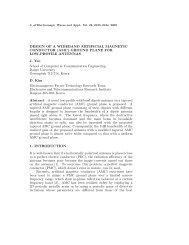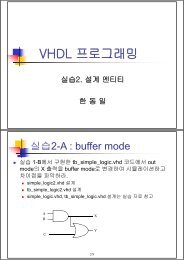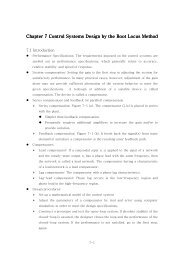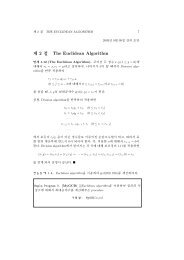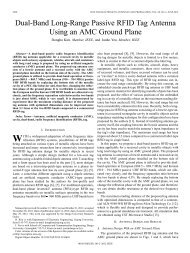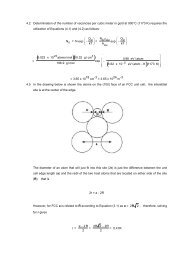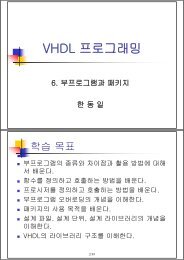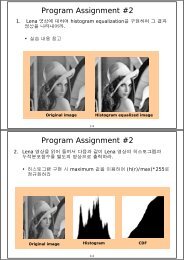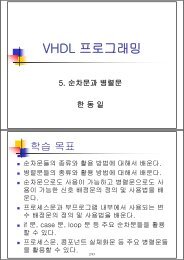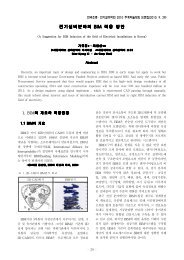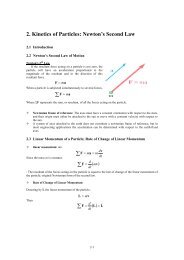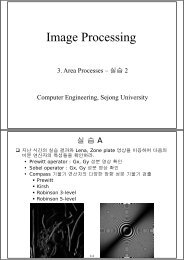Classification of rice cultivars based on cluster analysis of hydration ...
Classification of rice cultivars based on cluster analysis of hydration ...
Classification of rice cultivars based on cluster analysis of hydration ...
Create successful ePaper yourself
Turn your PDF publications into a flip-book with our unique Google optimized e-Paper software.
166<br />
2.8. Cluster <strong>analysis</strong> for <str<strong>on</strong>g>rice</str<strong>on</strong>g> <str<strong>on</strong>g>cultivars</str<strong>on</strong>g> classificati<strong>on</strong><br />
Hierarchical <strong>cluster</strong>ing method was applied to the processability<br />
data for classificati<strong>on</strong> <str<strong>on</strong>g>of</str<strong>on</strong>g> <str<strong>on</strong>g>rice</str<strong>on</strong>g> <str<strong>on</strong>g>cultivars</str<strong>on</strong>g>. The processability data sets,<br />
the hydrati<strong>on</strong> and the pasting parameters <str<strong>on</strong>g>of</str<strong>on</strong>g> the starch suspensi<strong>on</strong>s,<br />
were used to classify 12 <str<strong>on</strong>g>rice</str<strong>on</strong>g> <str<strong>on</strong>g>cultivars</str<strong>on</strong>g> into several groups.<br />
Hydrati<strong>on</strong> parameters were normalized whereas other parameters<br />
were the values measured instrumentally. Hierarchical <strong>cluster</strong>ing<br />
method is <str<strong>on</strong>g>based</str<strong>on</strong>g> <strong>on</strong> the average linkage <strong>cluster</strong>ing a method <str<strong>on</strong>g>of</str<strong>on</strong>g><br />
calculating mean (Euclidean) distance between elements <str<strong>on</strong>g>of</str<strong>on</strong>g> each<br />
<strong>cluster</strong>. The average linkage <strong>cluster</strong>ing was carried out using SPSS<br />
s<str<strong>on</strong>g>of</str<strong>on</strong>g>tware (v. 12.0, SPSS Inc., Chicago, IL, USA).<br />
3. Results and discussi<strong>on</strong><br />
3.1. Amylose c<strong>on</strong>tent <str<strong>on</strong>g>of</str<strong>on</strong>g> <str<strong>on</strong>g>rice</str<strong>on</strong>g> starches<br />
Amylose c<strong>on</strong>tent <str<strong>on</strong>g>of</str<strong>on</strong>g> <str<strong>on</strong>g>rice</str<strong>on</strong>g> starches are listed in Table 1. Rice<br />
<str<strong>on</strong>g>cultivars</str<strong>on</strong>g> are generally classified depending <strong>on</strong> the amylose c<strong>on</strong>tent<br />
<str<strong>on</strong>g>of</str<strong>on</strong>g> their starches into waxy, low amylose, medium amylose, and<br />
high amylose varieties which c<strong>on</strong>tain 0e2, 9e20, 20e25, and over<br />
25 g/100 g amylose, respectively (Mitchell, 2009). In this study, the<br />
<str<strong>on</strong>g>rice</str<strong>on</strong>g> starches <str<strong>on</strong>g>of</str<strong>on</strong>g> <str<strong>on</strong>g>cultivars</str<strong>on</strong>g> A and B, <str<strong>on</strong>g>cultivars</str<strong>on</strong>g> C, D, E and F, <str<strong>on</strong>g>cultivars</str<strong>on</strong>g> G,<br />
H, I and J, and <str<strong>on</strong>g>cultivars</str<strong>on</strong>g> K and L were categorized into groups <str<strong>on</strong>g>of</str<strong>on</strong>g> high<br />
amylose, medium amylose, low amylose, and waxy <str<strong>on</strong>g>rice</str<strong>on</strong>g> starches,<br />
respectively.<br />
3.2. Hydrati<strong>on</strong> properties <str<strong>on</strong>g>of</str<strong>on</strong>g> <str<strong>on</strong>g>rice</str<strong>on</strong>g> starches<br />
Hydrati<strong>on</strong> properties including WAI, WS, and SP <str<strong>on</strong>g>of</str<strong>on</strong>g> <str<strong>on</strong>g>rice</str<strong>on</strong>g> starches<br />
at 80 C are showed in Table 2. The WAI values <str<strong>on</strong>g>of</str<strong>on</strong>g> the <str<strong>on</strong>g>rice</str<strong>on</strong>g> starches<br />
from the <str<strong>on</strong>g>cultivars</str<strong>on</strong>g> B, E, and H were similar but their amylose levels<br />
showed a significant difference as shown in Table 1. Especially, the<br />
WAI <str<strong>on</strong>g>of</str<strong>on</strong>g> the starch in cultivar B was relatively high in spite <str<strong>on</strong>g>of</str<strong>on</strong>g> c<strong>on</strong>taining<br />
high amylose c<strong>on</strong>tent. These results are not in agreement<br />
with previous findings that the WAI <str<strong>on</strong>g>of</str<strong>on</strong>g> the starches with high<br />
amylose c<strong>on</strong>tent tend to be relatively low since amylose is hardly<br />
c<strong>on</strong>verted into amorphous state compared to amylopectin (Lee,<br />
Han, Lee, Kim, & Chung, 1989). The WAI <str<strong>on</strong>g>of</str<strong>on</strong>g> the starches <str<strong>on</strong>g>of</str<strong>on</strong>g> waxy<br />
<str<strong>on</strong>g>rice</str<strong>on</strong>g> <str<strong>on</strong>g>cultivars</str<strong>on</strong>g> (high amylopectin) were relatively low. The low WAI<br />
values <str<strong>on</strong>g>of</str<strong>on</strong>g> the waxy starches were not due to their low waterbinding<br />
capacity, but because amount <str<strong>on</strong>g>of</str<strong>on</strong>g> soluble fracti<strong>on</strong> in the<br />
waxy starches was relatively larger than that present in the n<strong>on</strong>glutinous<br />
starches. The waxy starches are easily solubilized by<br />
water so that their wet sediment weights fall <str<strong>on</strong>g>of</str<strong>on</strong>g>f after the centrifugati<strong>on</strong><br />
for the WAI <strong>analysis</strong>. Herein, the amylose c<strong>on</strong>tent does not<br />
Table 2<br />
Pasting and hydrati<strong>on</strong> properties <str<strong>on</strong>g>of</str<strong>on</strong>g> <str<strong>on</strong>g>rice</str<strong>on</strong>g> starches.<br />
WAI WS (%) SP PV (Pa s) T (Pa s) FV (Pa s) BD (Pa s) SB (Pa s)<br />
Rice A 7.00 e<br />
9.19 d<br />
7.70 c 2.19 g<br />
1.45 cd 3.83 b<br />
0.75 g<br />
2.38 a<br />
B 12.05 a<br />
17.29 c 13.26 b 3.79 c<br />
1.61 b<br />
4.09 a<br />
2.18 dc<br />
2.47 a<br />
C 8.80 cd<br />
4.32 d<br />
9.20 c 3.23 e<br />
1.31 e<br />
2.44 ef<br />
1.92 e<br />
1.13 d<br />
D 9.31 cbd 4.60 d<br />
9.76 cb 3.24 e<br />
1.30 e<br />
2.46 ef<br />
1.95 e<br />
1.17 d<br />
E 12.31 a<br />
7.42 d 13.29 b 4.25 b<br />
1.52 cb 3.17 c<br />
2.74 a<br />
1.66 b<br />
F 10.64 b<br />
5.38 d 11.24 cb 4.31 ba<br />
1.82 a<br />
3.20 c<br />
2.49 b<br />
1.37 c<br />
G 8.61 d<br />
4.72 d<br />
9.04 c 3.39 de<br />
1.37 ed 2.48 e<br />
2.03 de<br />
1.12 d<br />
H 12.27 a<br />
6.92 d 13.18 b 4.13 b<br />
1.35 ed 2.72 d<br />
2.78 a<br />
1.37 c<br />
I 10.14 cb<br />
6.25 d 10.83 cb 3.39 de<br />
1.12 f<br />
2.38 ef<br />
2.27 c<br />
1.26 dc<br />
J 7.90 ed<br />
4.37 d<br />
8.26 c 2.51 f<br />
1.49 c<br />
3.09 c<br />
1.03 f<br />
1.61 b<br />
K 8.16 ed 53.92 b 17.63 a 4.55 a<br />
1.72 a<br />
2.56 de<br />
2.83 a<br />
0.84 e<br />
L 4.75 f<br />
79.41 a 22.76 a 3.61 dc<br />
1.52 cb 2.27 f<br />
2.09 dce<br />
0.75 e<br />
WAI: water absorpti<strong>on</strong> index, WS: water solubility, SP: swelling power, PV: peak<br />
viscosity, T: though viscosity, FV: final viscosity, BD: breakdown, SB: setback.<br />
Means with the different letters in the same column are significantly different at the<br />
5% level.<br />
I. Lee et al. / LWT - Food Science and Technology 48 (2012) 164e168<br />
represent properly the processability properties including WAI,<br />
which exhibited difference am<strong>on</strong>g the <str<strong>on</strong>g>rice</str<strong>on</strong>g> starches even with<br />
similar amylose c<strong>on</strong>tent.<br />
Cultivars L and K, the high amylopectin c<strong>on</strong>tent but low amylose<br />
varieties, showed high WS compared to others. On the c<strong>on</strong>trary,<br />
water solubility <str<strong>on</strong>g>of</str<strong>on</strong>g> the <str<strong>on</strong>g>rice</str<strong>on</strong>g> starches <str<strong>on</strong>g>of</str<strong>on</strong>g> <str<strong>on</strong>g>cultivars</str<strong>on</strong>g> A to J was less than<br />
10%. Up<strong>on</strong> heating insoluble starch swells by penetrated water and<br />
weakened infrastructure hydrogen b<strong>on</strong>ds, and corresp<strong>on</strong>dingly<br />
some fragments <str<strong>on</strong>g>of</str<strong>on</strong>g> the starch could be solubilized up<strong>on</strong> heating.<br />
Thus, WS depends <strong>on</strong> amount <str<strong>on</strong>g>of</str<strong>on</strong>g> soluble starch, which will vary<br />
with cultivar and processing c<strong>on</strong>diti<strong>on</strong>s including heat treatment.<br />
Especially, hydrogen b<strong>on</strong>ds can be easily weakened in the starch<br />
granules with high amylopectin c<strong>on</strong>tent.<br />
High swelling powers were observed with the <str<strong>on</strong>g>rice</str<strong>on</strong>g> starches <str<strong>on</strong>g>of</str<strong>on</strong>g><br />
<str<strong>on</strong>g>cultivars</str<strong>on</strong>g> L and K (Table 2). On the c<strong>on</strong>trary, the SP <str<strong>on</strong>g>of</str<strong>on</strong>g> starch <str<strong>on</strong>g>of</str<strong>on</strong>g> cultivar<br />
A was the lowest. The SP <str<strong>on</strong>g>of</str<strong>on</strong>g> a starch depends <strong>on</strong> the ratio and<br />
molecular weights <str<strong>on</strong>g>of</str<strong>on</strong>g> amylose and amylopectin, and also intra- and<br />
inter-molecular interacti<strong>on</strong>s. In general, amylose acts as an inhibitor<br />
<str<strong>on</strong>g>of</str<strong>on</strong>g> swelling but amylopectin is likely to swell due to the weakness <str<strong>on</strong>g>of</str<strong>on</strong>g><br />
the intra- and inter-molecular coherence in starch (Morris<strong>on</strong>, Tester,<br />
Snape, Law, & Gidley, 1993; Tester & Morris<strong>on</strong>, 1990).<br />
3.3. Pasting properties <str<strong>on</strong>g>of</str<strong>on</strong>g> <str<strong>on</strong>g>rice</str<strong>on</strong>g> starches<br />
Pasting properties <str<strong>on</strong>g>of</str<strong>on</strong>g> the <str<strong>on</strong>g>rice</str<strong>on</strong>g> starches are listed in Table 2.TheP<br />
values, maximum viscosity during sol/gel transiti<strong>on</strong> up<strong>on</strong> heating, <str<strong>on</strong>g>of</str<strong>on</strong>g><br />
the starches with high amylose c<strong>on</strong>tent were relatively low since they<br />
do not swell easily or get thicker. On the other hand, waxy starches<br />
have higher P values because they can easily swell and become pastes.<br />
The highest P value was observed with cultivar K while the lowest<br />
value was with cultivar A. The P values <str<strong>on</strong>g>of</str<strong>on</strong>g> the <str<strong>on</strong>g>rice</str<strong>on</strong>g> starches <str<strong>on</strong>g>of</str<strong>on</strong>g> the<br />
<str<strong>on</strong>g>cultivars</str<strong>on</strong>g> D and E were significantly different but their amylose<br />
c<strong>on</strong>tents were similar. On the c<strong>on</strong>trary, the P values <str<strong>on</strong>g>of</str<strong>on</strong>g> starches <str<strong>on</strong>g>of</str<strong>on</strong>g> the<br />
<str<strong>on</strong>g>cultivars</str<strong>on</strong>g> C and J were similar though their amylose c<strong>on</strong>tents were<br />
varied c<strong>on</strong>siderably. In c<strong>on</strong>clusi<strong>on</strong>, amylose c<strong>on</strong>tent is not correlated<br />
closely with the P value which is <strong>on</strong>e <str<strong>on</strong>g>of</str<strong>on</strong>g> important parameters that<br />
need to be c<strong>on</strong>sidered for the starch processability. It is advantageous<br />
to characterize starches <str<strong>on</strong>g>of</str<strong>on</strong>g> different <str<strong>on</strong>g>cultivars</str<strong>on</strong>g> <str<strong>on</strong>g>based</str<strong>on</strong>g> <strong>on</strong> the processing<br />
parameters including P value, instead <str<strong>on</strong>g>of</str<strong>on</strong>g> amylose c<strong>on</strong>tent.<br />
T values, which represent the lowest viscosity up<strong>on</strong> heating, <str<strong>on</strong>g>of</str<strong>on</strong>g><br />
the <str<strong>on</strong>g>rice</str<strong>on</strong>g> starches were presumably observed at the end <str<strong>on</strong>g>of</str<strong>on</strong>g> heating at<br />
95 C. The highest T value observed with cultivar F while cultivar I<br />
exhibited the lowest am<strong>on</strong>g the <str<strong>on</strong>g>cultivars</str<strong>on</strong>g> studied.<br />
F values represent the viscosity <str<strong>on</strong>g>of</str<strong>on</strong>g> starch paste after cooling to<br />
50 C. The F values <str<strong>on</strong>g>of</str<strong>on</strong>g> <str<strong>on</strong>g>cultivars</str<strong>on</strong>g> A and B were the highest. The high<br />
amylose <str<strong>on</strong>g>rice</str<strong>on</strong>g> starches showed relatively high F values since starch<br />
pastes formed after heating likely to become harder dramatically<br />
up<strong>on</strong> cooling. On the c<strong>on</strong>trary, amylopectin-rich starch (cultivar L)<br />
developed into a clear paste with low viscosity. The F values <str<strong>on</strong>g>of</str<strong>on</strong>g> the<br />
<str<strong>on</strong>g>rice</str<strong>on</strong>g> starches <str<strong>on</strong>g>of</str<strong>on</strong>g> the <str<strong>on</strong>g>cultivars</str<strong>on</strong>g> I and J were differed significantly but<br />
their amylose c<strong>on</strong>tents are similar. However, the F values <str<strong>on</strong>g>of</str<strong>on</strong>g><br />
starches <str<strong>on</strong>g>of</str<strong>on</strong>g> the <str<strong>on</strong>g>cultivars</str<strong>on</strong>g> D and G exhibited close similarity but their<br />
amylose c<strong>on</strong>tents are varied c<strong>on</strong>siderably.<br />
Breakdown values reflect the heat stability at 95 C. After initial<br />
gelatinizati<strong>on</strong>, c<strong>on</strong>tinuous exposure <str<strong>on</strong>g>of</str<strong>on</strong>g> starch paste to high<br />
temperature lowers its viscosity. In general, hardness <str<strong>on</strong>g>of</str<strong>on</strong>g> starch<br />
paste is high at low temperature, vice versa, as temperature and<br />
texture are mutually dependent and in reversible manner. Hence<br />
a high breakdown value may be c<strong>on</strong>sidered as a relatively low heat<br />
stability point because low value indicates thermal stability (Karim,<br />
Norziah, & Seow, 2000). Breakdown values <str<strong>on</strong>g>of</str<strong>on</strong>g> the <str<strong>on</strong>g>rice</str<strong>on</strong>g> starches <str<strong>on</strong>g>of</str<strong>on</strong>g><br />
the <str<strong>on</strong>g>cultivars</str<strong>on</strong>g> D and E were differed significantly but their amylose<br />
c<strong>on</strong>tents are similar. On the c<strong>on</strong>trary, the breakdown values <str<strong>on</strong>g>of</str<strong>on</strong>g> the<br />
<str<strong>on</strong>g>rice</str<strong>on</strong>g> starches in the <str<strong>on</strong>g>cultivars</str<strong>on</strong>g> E and H present similar breakdown<br />
values but their amylose c<strong>on</strong>tents are varied c<strong>on</strong>siderably.



